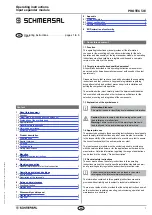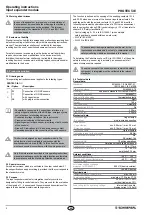
3
PROTECT-IE
Operating instructions
Input expander module
EN
Monitored inputs:
Cross-wire detection (Y/N):
Yes
Wire breakage detection (Y/N):
Yes
Earth leakage detection (Y/N):
Yes
Number of NO contacts:
variant 02: 0; variant 11: 4
Number of NC contacts:
variant 02: 8; variant 11: 4
Conduction resistance:
max. 40 Ω
Outputs:
Number of enabling paths:
2
Number of auxiliary contacts:
0
Number of signalling outputs:
4
Switching capacity of the enabling paths:
13-14; 23-24: max. 24 V / 2 A
ohmic (inductive with suitable
protective circuit); min. 10 V / 10 mA
Recommended fuse for the enabling paths:
2 A slow blow
Switching capacity of the signalling outputs:
Y1 … Y4:
24 VDC / 100 mA
Dimensions H x W x D:
126 mm x 48 mm x 61 mm
The data specified in this manual is applicable when the
component is operated with rated operating voltage U
e
± 0%
.
2.5 Safety classification
Standards:
IEC 62061, ISO 13849-1, IEC 61508
PL:
up to d
Control category:
up to 3
DC:
> 60 % (low)
CCF:
> 65 points
PFH value:
2.00 x 10
-7
/h
SIL:
up to 2
Service life:
20 years
The PFH value of 2.00 x 10
-7
/h applies to the combinations of contact
load (current through enabling contacts) and number of switching
cycles (n
op/y
) mentioned in the table below.
At 365 operating days per year and a 24-hours operation, this results in
the below-mentioned switching cycle times (t
cycle
) for the relay contacts.
Diverging applications upon request.
Contact load
n
op/y
t
cycle
20 %
525,600
1.0 min
40 %
210,240
2.5 min
60 %
75,087
7.0 min
80 %
30,918
17.0 min
100 %
12,223
43.0 min
The above-described requirements cannot be met by the
input expander module solely, but only in combination with a
safety-monitoring module as described in this manual.
3. Mounting
3.1 General mounting instructions
Mounting: snaps onto standard DIN rails to EN 60715.
Snap the bottom of the enclosure slightly tilted backwards in the DIN
rail and push down until it latches in position.
To avoid EMC disturbances, the physical ambient and
operational conditions at the place where the product is
installed, must meet the provisions laid down in the
paragraph "Electromagnetic Compatibility (EMC)"
of EN 60204-1.
3.2 Dimensions
All measurements in mm.
Device dimensions (H/W/D): 126 × 48 × 61 mm
with plug-in terminals: 126 × 48 × 53 mm
4. Electrical connection
4.1 General information for electrical connection
As far as the electrical safety is concerned, the protection
against unintentional contact of the connected and therefore
electrically interconnected apparatus and the insulation of the
feed cables must be designed for the highest voltage, which
can occur in the device.
The electrical connection may only be carried out by authorised
personnel in a de-energised condition.
Wiring examples: see appendix
5. Operating principle and settings
5.1 LED functions
• U
B
: Status operating voltage (LED is on, when the operating voltage
on the terminals is ON)
• Y1…Y4: Status of the inputs S1…S8 (LED is on, when the allocated
input circuit is opened)
5.2 Description of the terminals
Voltages:
A1
A2
+
–
S1 … S8
+24 VDC
0 VDC
24 VDC
0 VDC
+24 VDC / 0 VDC
Outputs:
13-14
23-24
1. Enabling circuit
2. Enabling circuit
Start:
Y1 … Y4 Status of the inputs (+24 V, when the
allocated input circuit is opened)
S5
IE..
S1
S6
UB
+
+
+
+
Y2
S3
Y1
13
23
–
A2
S4
S7
24
A2
14
A1
A1
Y3 Y4
– S8
S2
–
–
Fig. 1
Signalling outputs must not be used in safety circuits.
6. Set-up and maintenance
6.1 Functional testing
The function of the component must be tested. The following conditions
must be previously checked and met:
1. Correct fixing
2. Check the integrity of the cable entry and connections
3. Check the switch enclosure for damage
4. Check the electrical function of the connected sensor technology and
their influence on the safety-monitoring module and the downstream
actuators
























